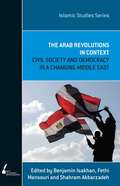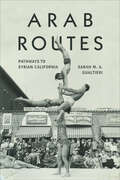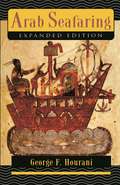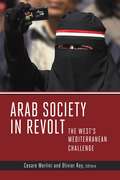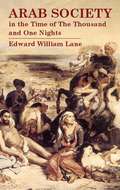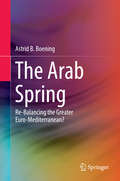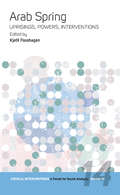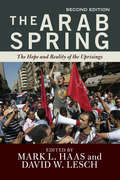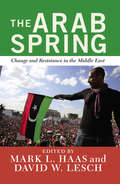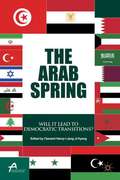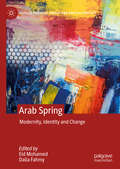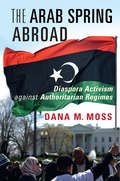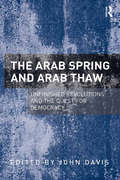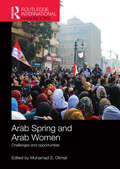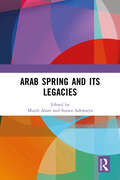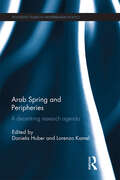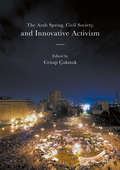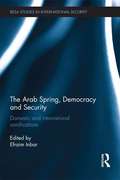- Table View
- List View
Arab Revolutions in Context: Civil Society and Democracy in a Changing Middle East (Islamic Studies Series)
by Benjamin Isakhan Fethi Mansouri Shahram AkbarzadehFrom late 2010 a series of dramatic and unprecedented events swept across the Middle East and North Africa, toppling several autocratic regimes that had held power for decades and ushering in a new climate of dissent and democratisation. The Arab Revolutions in Context seizes a unique opportunity to reflect on these seismic events, their causes and consequences, and the core issues facing the region as it moves forward. This volume is more than a collection of detailed thematic essays.It situates the Arab Revolutions within their broader contextual backgrounds—showing that a unique set of historical events, as well as local, regional and global dynamics, has converged to provide the catalyst that triggered the recent revolts-and also within a new conceptual framework. The argument here is that the Arab Revolutions pose a very specific challenge to conventional wisdom concerning democracy and democratisation in the Middle East. The Arab Revolutions in Context is the first volume of its kind to address the Arab Revolutions and the varying analyses, debates and discussions that they have stimulated. Islamic Studies Series - Volume 12
Arab Routes: Pathways to Syrian California (Stanford Studies in Comparative Race and Ethnicity)
by Sarah GualtieriLos Angeles is home to the largest population of people of Middle Eastern origin and descent in the United States. Since the late nineteenth century, Syrian and Lebanese migration, in particular, to Southern California has been intimately connected to and through Latin America. Arab Routes uncovers the stories of this Syrian American community, one both Arabized and Latinized, to reveal important cross-border and multiethnic solidarities in Syrian California. Sarah M. A. Gualtieri reconstructs the early Syrian connections through California, Texas, Mexico, and Lebanon. She reveals the Syrian interests in the defense of the Mexican American teens charged in the 1942 Sleepy Lagoon murder, in actor Danny Thomas's rise to prominence in LA's Syrian cultural festivals, and in more recent activities of the grandchildren of immigrants to reclaim a sense of Arabness. Gualtieri reinscribes Syrians into Southern California history through her examination of powerful images and texts, augmented with interviews with descendants of immigrants. Telling the story of how Syrians helped forge a global Los Angeles, Arab Routes counters a long-held stereotype of Arabs as outsiders and underscores their longstanding place in American culture and in interethnic coalitions, past and present.
Arab Seafaring: In the Indian Ocean in Ancient and Early Medieval Times - Expanded Edition
by George F. HouraniIn this classic work George Hourani deals with the history of the sea trade of the Arabs in the Indian Ocean from its obscure origins many centuries before Christ to the time of its full extension to China and East Africa in the ninth and tenth centuries. The book comprises a brief but masterly historical account that has never been superseded. The author gives attention not only to geography, meteorology, and the details of travel, but also to the ships themselves, including a discussion of the origin of stitched planking and of the lateen fore-and-aft sails. Piracy in the Indian Ocean, day-to-day life at sea, the establishment of ancient lighthouses and the production of early maritime guides, handbooks, and port directories are all described in fascinating detail. Arab Seafaring will appeal to anyone interested in Arab life or the history of navigation. For this expanded edition, John Carswell has added a new introduction, a bibliography, and notes that add material from recent archaeological research.
Arab Society: Continuity and Change (Routledge Revivals)
by Samih K. FarsounThe Arab world has long been subjected to super-power rivalry for influence and control. The area has been characterized by bloody conflict with Israel and the internal instability that has been particularly prevalent in the last few years. Whilst these political struggles have been highly visible and at times spectacular over the decades, other transformations have taken place within the societies and peoples of the region, on a less pronounced – although just as profound – scale. The integration of the region into the world economy and the spread of Islamic revivalism are perhaps the most significant of these transformations. This volume, inspired by a lecture series on the Arab world in transition at the American University, Washington D.C., was first published in 1985. It discusses a wide range of issues, from economic to religious, which together form an in-depth analysis of the complex processes of transformation in Arab society. This is a fascinating work that holds the same interest and value to scholars and students of Middle Eastern history, politics and domestic affairs, as it did when it was first published.
Arab Society in Revolt
by Cesare Merlini Olivier RoyFor every pithy conceptualization of complex events, there are additional lenses through which to examine them. One of the several virtues of this book is precisely that it brings different perspectives to bear on the complexity, diversity, and uncertainty of recent and current events in the Arab world. The thirteen authors concentrate on the critical social forces shaping the region-demography, religion, gender, telecommunication connectivity, and economic structures-and they are painstakingly analyzed and evaluated.-from the foreword by Strobe Talbott, president of the Brookings InstitutionThe Arab Spring will be remembered as a period of great change for the Arab states of North Africa and the eastern Mediterranean. Facing fundamental transitions in governance, these countries are also undergoing profound social, cultural, and religious changes. The European Union and the United States, caught unprepared by the uprisings, now must address the inescapable challenges of those changes. How will the West respond to these new realities, particularly in light of international economic uncertainty, EU ambivalence toward a "cohesive foreign policy," and declining U.S. influence abroad? Arab Society in Revolt explains and interprets the societal transformations occurring in the Arab Muslim world, their ramifications for the West, and possible policy options for dealing with this new world. Arab Society in Revolt examines areas of change particularly relevant in the southern Mediterranean: demography and migration, Islamic revival and democracy, rapidly changing roles of women in Arab society, the Internet in Arab societies, commercial and social entrepreneurship as change factors, and the economics of Arab transitions. The book then looks at those cultural and religious as well as political and economic factors that have influenced the Western response, or lack of it, to the Arab Spring as well as the policy options that remain open.
Arab Society in Revolt
by Cesare Merlini Olivier RoyFor every pithy conceptualization of complex events, there are additional lenses through which to examine them. One of the several virtues of this book is precisely that it brings different perspectives to bear on the complexity, diversity, and uncertainty of recent and current events in the Arab world. The thirteen authors concentrate on the critical social forces shaping the region--demography, religion, gender, telecommunication connectivity, and economic structures--and they are painstakingly analyzed and evaluated.--from the foreword by Strobe Talbott, president of the Brookings InstitutionThe Arab Spring will be remembered as a period of great change for the Arab states of North Africa and the eastern Mediterranean. Facing fundamental transitions in governance, these countries are also undergoing profound social, cultural, and religious changes. The European Union and the United States, caught unprepared by the uprisings, now must address the inescapable challenges of those changes. How will the West respond to these new realities, particularly in light of international economic uncertainty, EU ambivalence toward a "cohesive foreign policy," and declining U.S. influence abroad? Arab Society in Revolt explains and interprets the societal transformations occurring in the Arab Muslim world, their ramifications for the West, and possible policy options for dealing with this new world. Arab Society in Revolt examines areas of change particularly relevant in the southern Mediterranean: demography and migration, Islamic revival and democracy, rapidly changing roles of women in Arab society, the Internet in Arab societies, commercial and social entrepreneurship as change factors, and the economics of Arab transitions. The book then looks at those cultural and religious as well as political and economic factors that have influenced the Western response, or lack of it, to the Arab Spring as well as the policy options that remain open.
Arab Society in the Time of The Thousand and One Nights
by Edward William LaneElaborate, explanatory notes from the author's 1859 translation of the Arabian Nights comprise a virtual encyclopedia of Middle Eastern life. Intriguing account of Islamic society as it existed during the Middle Ages considers importance of religion, literature, festivals, education, slavery, role of women in society, and rituals observed for the dead.
The Arab Spring
by Astrid B. BoeningBeginning in 2010, there has been a consolidating cooperation among existing powers in the Euro-Mediterranean in face of the rapid de-stabilization of the Arab region. This fact alone accelerated the hesitant responses by the EU towards emerging hegemons, particularly Russia and China, who in-turn applied traditional mechanisms of increasing regional economic influence to bolster their political influence, but with the difference that a normative influence is missing, in contrast to the EU's and US' influence, which is strongly centered on universal norms pertaining to political, economic and social-cultural norms. This book examines the Arab Spring not only from its intra but also inter-regional geo-political and strategic implications by analyzing the Euro-Mediterranean region following the onset of the Arab Spring. It aims to connect the broader economic and political strands of power shifts that have taken place since the Arab Spring, making it of interests to political scientists and policy-makers concerned with the Mediterranean and Euro-Arab relations.
Arab Spring
by Kjetil FosshagenThe events of the Arab Spring presented a dramatic reconstitution of politics and the public sphere through their aesthetic and performative uses of public space. Mass demonstrations have become a new global political form, grounded in the localization of globalizing processes, institutions, and relationships. This volume delves beneath the seemingly chaotic nature of events to explore the structural dynamics underpinning popular resistance and their support or suppression. It moves beyond what has usually been defined as Arab Spring nations to include critical views on Bahrain, the Palestinian territories, and Turkey. The research and analysis presented explores not just the immediate protests, but also the historical realization, appropriation, and even institutionalization of these critical voices, as well as the role of international criminal law and legal exceptionalism in authorizing humanitarian interventions. Above all, it questions whether the revolutions have since been hijacked and the broad popular uprisings already overrun, suppressed, or usurped by the upper classes.
The Arab Spring: The Hope and Reality of the Uprisings
by Mark L. HaasBeginning in late 2010, peaceful protests against entrenched regimes unexpectedly erupted in a number of Arab countries, causing political upheaval across the region. Through contributions from noted scholars, The Arab Spring provides a comprehensive overview of the causes, key issues, and aftermath of these events. Divided into two parts, the book first examines the Arab countries most dramatically impacted by the uprisings, as well as why some of their Arab neighbors avoided large-scale protests. The second part explores other countries?inside and outside the region-that have a stake and interest in the uprisings.The second edition includes a new chapter on Iraq and coverage of developments in the region since 2012 and how they have altered initial assessments of the Arab Spring's effects. New part introductions and a revised concluding chapter provide contextualization and comparative analyses of key themes and broader questions. This is an essential volume for students and scholars seeking the fullest understanding of how the Arab uprisings continue to impact the region and the world.
The Arab Spring
by Mark L. Haas David W. LeschThe Arab Spring unexpectedly developed in late 2010 with peaceful protests in a number of Arab countries against long-standing, entrenched regimes, and rapid political change across the region ensued. The Arab Spring: Change and Resistance in the Middle East examines these revolutions and their aftermath. Noted authorities writing specifically for this volume contribute chapters focusing on countries directly or indirectly involved, illuminating the immediate and long-term impacts of the revolutions in the region and throughout the world. A thoughtful concluding chapter ties together key themes, while also delineating persistent myths and misinterpretations. This is an essential volume for students and scholars of the Middle East, as well as anyone seeking a fuller understanding of region and what may lie ahead.
The Arab Spring: Change and Resistance in the Middle East
by Mark L. Haas David W. LeschThe Arab Spring unexpectedly developed in late 2010 with peaceful protests in a number of Arab countries against long-standing, entrenched regimes, and rapid political change across the region ensued. The Arab Spring: Change and Resistance in the Middle East examines these revolutions and their aftermath. Noted authorities writing specifically for this volume contribute chapters focusing on countries directly or indirectly involved, illuminating the immediate and long-term impacts of the revolutions in the region and throughout the world. A thoughtful concluding chapter ties together key themes, while also delineating persistent myths and misinterpretations. This is an essential volume for students and scholars of the Middle East, as well as anyone seeking a fuller understanding of region and what may lie ahead.
The Arab Spring
by Clement Henry Jang Ji-HyangThis timely project on the Arab Spring was initiated to provide The Asan Institute's own assessment of the changes currently taking place in the region and their significant implications for South Korea.
The Arab Spring
by David W. Lesch Mark L. HaasThe Arab Spring unexpectedly developed in late 2010 with peaceful protests in a number of Arab countries against long-standing, entrenched regimes, and rapid political change across the region ensued. The Arab Spring: Change and Resistance in the Middle East examines these revolutions and their aftermath. Noted authorities writing specifically for this volume contribute chapters focusing on countries directly or indirectly involved, illuminating the immediate and long-term impacts of the revolutions in the region and throughout the world. A thoughtful concluding chapter ties together key themes, while also delineating persistent myths and misinterpretations. This is an essential volume for students and scholars of the Middle East, as well as anyone seeking a fuller understanding of region and what may lie ahead.
The Arab Spring: The Hope and Reality of the Uprisings
by David W. Lesch Mark L. HaasBeginning in late 2010, peaceful protests against entrenched regimes unexpectedly erupted in a number of Arab countries, causing political upheaval across the region. Through contributions from noted scholars, The Arab Spring provides a comprehensive overview of the causes, key issues, and aftermath of these events. Divided into two parts, the book first examines the Arab countries most dramatically impacted by the uprisings, as well as why some of their Arab neighbors avoided large-scale protests. The second part explores other countries—inside and outside the region—that have a stake and interest in the uprisings.The second edition includes a new chapter on Iraq and coverage of developments in the region since 2012 and how they have altered initial assessments of the Arab Spring's effects. New part introductions and a revised concluding chapter provide contextualization and comparative analyses of key themes and broader questions. This is an essential volume for students and scholars seeking the fullest understanding of how the Arab uprisings continue to impact the region and the world.
The Arab Spring
by David W. Lesch Mark L. HaasThe Arab Spring unexpectedly developed in late 2010 with peaceful protests in a number of Arab countries against long-standing, entrenched regimes, and rapid political change across the region ensued. The Arab Spring: Change and Resistance in the Middle East examines these revolutions and their aftermath. Noted authorities writing specifically for this volume contribute chapters focusing on countries directly or indirectly involved, illuminating the immediate and long-term impacts of the revolutions in the region and throughout the world. A thoughtful concluding chapter ties together key themes, while also delineating persistent myths and misinterpretations. This is an essential volume for students and scholars of the Middle East, as well as anyone seeking a fuller understanding of region and what may lie ahead.
Arab Spring: Modernity, Identity and Change (Critical Political Theory and Radical Practice)
by Eid Mohamed Dalia FahmyThis book provides systematic, integrated analyses of emergent social and cultural dynamics in the wake of the so-called Arab Spring, and looks closely at the narratives and experiences of a people as they confront crisis during a critical moment of transition. Providing an interdisciplinary approach to interconnections across regional and communal boundaries, this volume situates itself at the intersection of political science, cultural studies, media and film studies, and Middle Eastern studies, while offering some key critical revisions to dominant approaches in social and political theory. Through the unique contributions of each of its authors, this book will offer a much-needed addition to the study of Middle East politics and the Arab Spring. Moreover, although its specific focus is on the Arab context, its analysis will be of issues of significant relevance to a changing world order.
The Arab Spring Abroad: Diaspora Activism against Authoritarian Regimes (Cambridge Studies in Contentious Politics)
by Dana M. MossThe Arab Spring revolutions of 2011 sent shockwaves across the globe, mobilizing diaspora communities to organize forcefully against authoritarian regimes. Despite the important role that diasporas can play in influencing affairs in their countries of origin, little is known about when diaspora actors mobilize, how they intervene, or what makes them effective. This book addresses these questions, drawing on over 230 original interviews, fieldwork, and comparative analysis. Examining Libyan, Syrian, and Yemeni mobilization from the US and Great Britain before and during the revolutions, Dana M. Moss presents a new framework for understanding the transnational dynamics of contention and the social forces that either enable or suppress transnational activism. This title is also available as Open Access on Cambridge Core.
The Arab Spring and Arab Thaw: Unfinished Revolutions and the Quest for Democracy
by John DavisWhat were the unifying principles or strategies that governed the protest movements that swept the Middle East and North Africa in the spring of 2011? Who were the protestors and how did the different authoritarian regimes respond to them? How did regional and international institutions react to a region in turmoil? The Arab Spring and Arab Thaw; Unfinished Revolutions and the Quest for Democracy addresses these questions by examining a range of successful and unsuccessful protest strategies and counter revolutionary tactics employed by protestors and autocratic regimes. Contributors explore the reactions of the USA, EU and Arab League to events in the region and provide insight as to the gendered dimensions of the struggle along with the ethnic and tribal divisions that continue to impact the post-revolt period. By addressing these critical queries the book demonstrate how the Arab Spring has evolved into a protracted Arab Thaw that continues to profoundly affect regional and international politics.
Arab Spring and Arab Women
by Muhamad S. OlimatThis volume examines the role of Arab women in Arab Spring and their contribution to the ongoing process of change sweeping the region. The book begins with an examination of the process of democratization and its impediments in the Arab World since the Second World War. It then looks at the conditions that led to the upsurge of the so-called Arab Spring. Finally, it underscores women’s role as participants, organizers, leaders, but also as victims. The main thesis of the book is that while Arab women were an integral part of the revolutionary efforts within the Arab Spring paradigm, they did not benefit from their sacrifices. Although they continue to be part of the process of change, their gains, rights and scope for participation are still limited. If the expansion of women’s participation and the scope of their rights do not seem to be a priority for revolutionary forces, women have made remarkable achievements, especially in some Arab Spring countries such as Yemen and Libya. The book includes case studies of some Arab Spring countries and other countries influenced by developments: Egypt, Bahrain, Kuwait, Libya, Yemen, Algeria, Jordan, Morocco and Saudi Arabia. It calls on revolutionary and reformist forces to give special attention to issues related to Arab women, as they are an indispensable pillar in the process of reform, development, peace and stability in the Middle East.
Arab Spring and Its Legacies
by Sujata Ashwarya Mujib AlamThe essays in this edited volume seek to understand the regional and international ramifications of the wave of protest demonstrations that swept across West Asia and North Africa in the early 2010s, both on the ground and online. Dissatisfaction with political repression and corruption, economic difficulties and inequities, and a desire for freedom and democracy all played a role in the Arab Spring uprisings. It deposed long-standing dictatorships, ushering in a period of insecurity and instability that would have long-term consequences for the region's political economy and international relations. Although the protests have ended, the legacy of that turbulent era will live on, most notably in the acceleration of regional change and transformation.Print edition not for sale in South Asia (India, Sri Lanka, Nepal, Bangladesh, Pakistan and Bhutan)
Arab Spring and Peripheries: A Decentring Research Agenda (Routledge Studies in Mediterranean Politics)
by Daniela Huber and Lorenzo KamelThe emerging literature on the so-called ‘Arab Spring’ has largely focused on the evolution of the uprisings in cities and power centres. In order to reach a more diversified and inner understanding of the ‘Arab Spring’, this edited book examines how peripheries have reacted and contributed to the historical dynamics at work in the Middle East and North Africa. It rejects the idea that the ‘Arab Spring’ is a unitary process and shows that it consists of diverse Springs which differed in terms of opportunity structure, strategies of a variance of actors, and outcomes. This book looks at geographical, religious, gender and ethnical peripheries, conceptualizing periphery as a dynamic structure which can expand and contract. It shows that the seeds for changing the face of politics and polities are within peripheries themselves. Focusing on the voices of peripheries can therefore be a powerful tool to ‘de-simplify’ the reading of the Arab Spring and to reshape the paradigmatic schemes through which to look at this part of the world.This book was published as a special issue of Mediterranean Politics.
The Arab Spring and the Geopolitics of the Middle East: Emerging Security Threats And Revolutionary Change
by Joseph R. Cerami Amr YossefIn this study, which highlights a renewed emphasis in international affairs on regional studies, the co-authors provide an assessment of the revolutionary changes in the politics and security of the Middle East and North Africa (MENA).
The Arab Spring, Civil Society, and Innovative Activism
by Cenap ÇakmakThis book investigates the role of society groups in the making of the Arab Spring and under which conditions they attained their goals. Democracy and recognition of human rights and fundamental freedoms seem to be the main drives of the people organized in form of civil groups or grassroots movements in the Arab Spring countries; but it is essential to identify when they find it suitable to take such extreme action as taking the streets in an attempt to take down the repressive regimes. It is also important to investigate what methods they relied on in their action and how they challenged the state and the government. A review of the cases in this volume shows that civil society has certain limitations in its action. Analysis of the cases also challenges a commonly held assumption that the Arab world does not have strong and rich civil society tradition. However, for a lasting success and consolidation of democracy, something more than civil society action is obviously needed. A strong organized opposition and a democratic culture seems to be indispensable elements for the evolution of a democratic order and tradition.
The Arab Spring, Democracy and Security: Domestic and International Ramifications
by Efraim InbarThis volume analyzes the political, economic and strategic dimensions of the recent upheavals in the Middle East known as the Arab Spring. Mass demonstrations in many Arab states challenged the political status quo and the existing political and cultural system in the region. While it is too early to offer a definitive analysis of the impact of the widespread discontent in the Arab world, the trajectory of the events indicates regime change in several states, containment of political unrest in most states, increase in Islamic tendencies, centrifugal tendencies in a number of political units and deterioration of economic conditions. This volume presents an initial assessment by a selected group of Israeli scholars of the implications of the Arab Spring. The chapters focus on important issues such as democratization, the role of economic factors in political change and explanations for variations in regime stability in the Middle East. Taking an international relations perspective, the book not only examines the evolving regional balance, but also explores the link between external and internal politics and the implications of terrorism for regional security. The chapters also address the implications of the Arab Spring for Israel and its chances of existing peacefully in the region. This volume will be of much interest to students of Middle East politics, international security, foreign policy and international relations.
